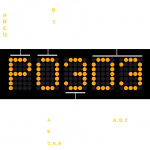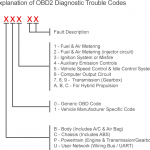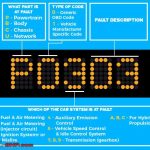The main purpose of a scan tool is to provide a diagnostic clue to an ailing car. But it rarely means that a part is required. Further diagnostics may be needed with a digital storage oscilloscope or other test equipment. Parts stores, in particular, are not in the repair business. They are more interested in selling their parts than in determining whether the parts are the solution to the problem. Most scan tool codes are used for emission faults.
OBD communication protocol
OBD (Obsidian Bus Definition) is the standard for the connection between a car and a diagnostic scanner. It specifies the type of diagnostic connector, electrical signalling protocols, messaging format, and the candidate list for vehicle parameters. An OBD-II-compatible scan tool requires a connector that can provide power from the car’s battery. Some technicians use a separate auxiliary power source.
OBD-II provides access to data from the engine control unit and offers valuable troubleshooting information. The OBD communication protocol is defined in the SAE J1979 standard and includes various modes. PIDs refer to parameters on the engine and are described by their min/max values. There are also formulas for each parameter that allows it to be converted from one format to another. The PIDs for the Vehicle Speed and the Engine RPM are defined in SAE J1979.
The OBD system has evolved since the OBD-I standard was introduced. The latest OBD-II system utilizes a standard digital communications port to provide real-time data and standardized diagnostic trouble codes to diagnose vehicle malfunctions. The diagnostic trouble codes allow for quick diagnosis of vehicle malfunctions. The DTC codes are a key component to the success of a car diagnostics system. However, a diagnostic scan tool may only show the code once it can read the connector.
The OBD-II communication protocol was originally developed for stationary emission controls. However, in many countries, a car cannot communicate with a scanner using this protocol. In China, however, the requirement to install an OBD-II protocol on all new vehicles is July 1, 2008, although there are regional exceptions. Additionally, HDOBD specification for selected commercial engines will be mandated in 2010
Diagnostic trouble codes
A diagnostic trouble code (DTC) reader is a device that reads these codes on a vehicle. It can also display one-line definitions of each code, if available. Basic code readers are likely to provide the code number, but a more advanced reader may include a database for the vehicle model in question. Regardless of which type of diagnostic trouble code reader you choose, these devices are essential for checking your vehicle’s engine.
To determine which diagnostic trouble code is right for your vehicle, you will need to know the format of the code. Diagnostic trouble codes have a first digit of two or three and start with an alphabetic character indicating the car part’s fault. After this, you will need to choose the code that corresponds to the fault. 0 represents a generic code (Sae International) and 1 denotes a manufacturer-specific code (MPG). The second digit, which is also called the fault code, is reserved and is also a subsystem code.
Not all problems will result in a DTC, but any problem will be detected by it. If the trouble code indicates a sensor circuit is out of range, then it means that the emission control system is malfunctioning. A DTC will provide a detailed description of a specific fault, but does not necessarily mean that the problem is severe. Once you understand how to read the code, you can begin repairing your vehicle.
A DTC can be caused by a variety of different things. A DTC can help you narrow down the problem by revealing the root of the problem. Often, the DTC will be used by the onboard diagnostics (OBD) system to identify specific vehicle problems. If the error persists, further diagnostics are necessary. You should also understand that clearing a code doesn’t make the problem go away. Your check engine light will come on again and you will have to repeat the process.
Letter prefix
The letter prefix for scan tool codes is an important consideration when interpreting diagnostic messages. A scan tool will retrieve a range of diagnostic messages in a predefined format based on the manufacturer’s specifications. In addition to a letter prefix, an OBD2 code contains four numbers – the first of which indicates the type of code, the second the specific system the vehicle is equipped with, and the last two the specific fault designation.
Diagnostic trouble codes are assigned a letter prefix – the first digit of the code is either a 2 or a 3 defining a subsystem of codes. Most common codes have a two or three-character prefix, and are divided into two types: generic and manufacturer-specific. The first two prefixes describe a general problem, while the third character indicates a particular vehicle system.
Typically, newer vehicle models share the same connector. However, some vehicles have slightly different hardware and software configurations. Nevertheless, you can get a good idea of which code reader you need by checking your vehicle’s manual. If you’re unsure of where to find the OBD-II connector, consult the vehicle owner’s manual. The latter is easier to find than the former. You’ll also need a software program to interpret the DTC fault codes.
Numbers
The numbering system used in obd-ii codes varies by car manufacturer. The more advanced scan tools are able to read these codes. The older ones, however, do not. The information they show is limited and can be misleading. The best way to interpret scan tool codes is to read them as they appear. The following are some common codes that appear in obd-ii systems. Read on to learn more about these codes and how to decipher them.
Diagnostic trouble codes have five digits, starting with p for powertrain-related problems. Professional-grade scanners may also show b and c codes, while u-codes are for computers and communications problems. These codes can help you to diagnose your car quickly. However, you should never ignore a code simply because it appears on your car’s dashboard. In addition, it could be a warning sign for something that is not so serious.
After you have chosen the type of code reader, you can choose to read the codes. In some cases, the tools may have a READ CODES button or a menu option for that. Some scan tools require you to input the model of your vehicle. The diagnostic fault codes will then be displayed on the display in numerical order. You may want to write down the code before you proceed. Remember to write down the codes in order of importance to you.
Unlike OBDII codes, DTCs contain specific information about your car. They include a letter prefix and four numbers. OBD2 codes are used to diagnose the vehicle’s issues. The first numeric digit defines the type of code. The second number indicates the specific vehicle system. The last two digits indicate the fault designation. These codes can be difficult to read, but they can be translated to simple, easy-to-understand terms.
Meaning of code
If you’re unsure of what a DTC code means, you can ask the car’s manufacturer or dealer for a definition. Or you can use diagnostics software to find out what the code means. Some models include the DTC definitions with the code, while others only display a one-line description. Whatever your method, it’s important to write down the code and its definition. If possible, you should also write down the vehicle’s serial number so that you can reference it in the future.
Scan tool codes are usually classified into two categories: OBD2 and powertrain. OBD2 codes relate to the engine and transmission, while body and chassis codes are for other systems. Lastly, network codes are for communication failures and module failures. Professional scanners can read and interpret non-powertrain codes. Using a scanner that specializes in OBD2 codes is the most reliable way to diagnose the issue.
When your vehicle’s diagnostic trouble code is a generic code, you should consult your vehicle’s owner’s manual. A scan tool with this function will display specific fault codes for each car model. It will also display a list of all known problems and possible solutions. If you don’t know what a DTC code means, a comprehensive fleet management solution will provide the meaning of the code. The meaning of these codes is an important part of fleet management. Ultimately, you’ll be able to determine the cause of the problem and take steps to remedy it.
The first digit of a diagnostic trouble code indicates the car’s system problem. For example, a P0301 code may be a code that indicates a malfunction in the powertrain. The second digit, “0”, represents a generic code for an OBD II system. The last two digits indicate which cylinder the code is for. A scan tool’s second digit, “1”, is reserved for the engine.






